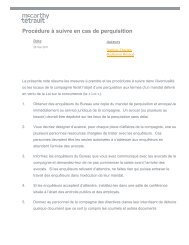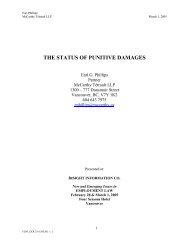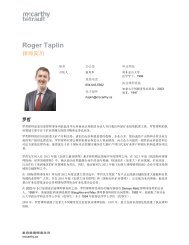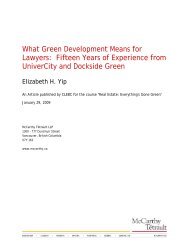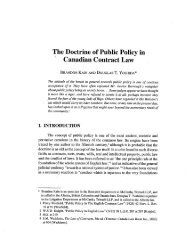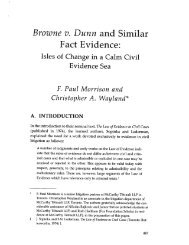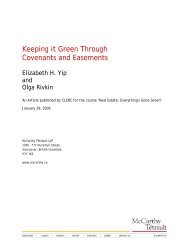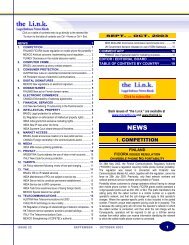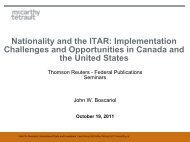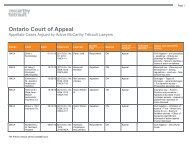Presentation Material - McCarthy Tétrault
Presentation Material - McCarthy Tétrault
Presentation Material - McCarthy Tétrault
You also want an ePaper? Increase the reach of your titles
YUMPU automatically turns print PDFs into web optimized ePapers that Google loves.
Chris Falk<br />
Stefanie Morand<br />
<strong>McCarthy</strong> Tétrault LLP<br />
How and When Capital Loss Carry-Back Planning and Pipeline Planning are Used<br />
As noted above, capital loss carry-back planning typically involves the winding-up of the<br />
corporation owned by the estate and/or a redemption of all or some portion of the estate’s<br />
shares therein, within the first taxation year of the estate. In effect, pursuant to the provisions of<br />
subsection 164(6), the capital gain realized on the deceased’s death can be offset wholly or in<br />
part by a capital loss triggered in the estate’s first taxation year on the winding-up or<br />
redemption. The winding-up or redemption will generally trigger corporate level tax on the<br />
disposition of assets and deemed dividends to the shareholders; however, where such<br />
dividends can be paid on a tax-efficient basis (e.g., paying capital dividends out of the<br />
corporation’s capital dividend account or paying dividends that give rise to a dividend refund to<br />
the corporation), capital loss carry-back planning is frequently beneficial.<br />
If dividends cannot be paid on a tax-efficient basis, a pipeline strategy may be more effective,<br />
particularly if the corporation in question has cash or other assets with nominal gains. 15<br />
Pipelines may be particularly attractive in Ontario where there is a very substantial difference<br />
between the highest marginal rate applicable to an individual on capital gains (i.e., 23.99%,<br />
given the 50% inclusion rate on capital gains and the top marginal rate of 47.97%) and on<br />
16, 17<br />
dividends that are not eligible dividends (i.e., 34.52%).<br />
In concept, pipeline planning preserves the capital gain on death while permitting assets of the<br />
corporation to be effectively distributed to the ultimate shareholder without adverse tax<br />
consequences to the shareholder. The planning may be illustrated by way of a simple<br />
example: 18<br />
• Mr. X dies owning all of the shares of a private corporation, XCo.<br />
• The shares of XCo were held by Mr. X as capital property for purposes of the Act and<br />
had an ACB to Mr. X of $100,000 and an FMV immediately prior to Mr. X’s death of<br />
$1,000,000. Accordingly, the deemed disposition of the XCo shares would give rise to a<br />
$900,000 capital gain in Mr. X’s terminal year (assuming no rollover to Mr. X’s spouse or<br />
to a spouse trust).<br />
• To create a “pipeline”, Mr. X’s estate would incorporate a new corporation, Newco, for<br />
nominal consideration. The estate would sell the shares of XCo to Newco for<br />
$1,000,000 (assuming no accrued gain or loss in the estate since Mr. X’s death). 19 The<br />
15<br />
16<br />
17<br />
18<br />
19<br />
Pipeline planning may also be more effective where a “bump” can be used to increase the ACB of nondepreciable<br />
capital assets. See note 14, above.<br />
The highest marginal rate on eligible dividends is 31.69% in Ontario for 2012. These rates include the 2% surtax<br />
on income above $500,000. Prior to the introduction of the 2% surtax, the highest marginal rates in Ontario were<br />
46.41% on interest and regular income, 23.21% on capital gains (given the 50% inclusion rate), 29.54% on<br />
eligible dividends and 32.57% on non-eligible dividends. These rates continue to apply for income over<br />
$132,406 up to $500,000.<br />
Private corporations that are or were formerly carrying on business and that have significant retained earnings<br />
(that did not give rise to capital dividends or to refundable tax) are often corporations in respect of which pipeline<br />
planning can be attractive.<br />
In this example, XCo and Newco are assumed to be taxable Canadian corporations as defined in subsections<br />
248(1) and 89(1).<br />
A section 85 rollover could, of course, be used if there were an accrued gain in the hands of the estate.<br />
560600/422632<br />
MT DOCS 11864055v1G<br />
4



